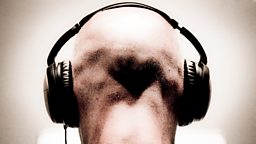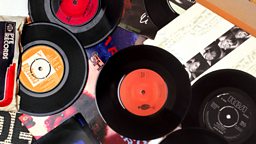6 ways to improve your enjoyment of music
8 May 2018
Are you listening carefully?

This week Gideon Coe presented “A Lights Out Special” playing three hours of music that sounds good in the dark – listen back to the show now (and close your eyes).
It certainly does seem that some music is improved with the lamps turned low but we wondered, scientifically speaking, does darkness actually improve your listening experience?
To find out for sure, and gain a few other ‘hacks’ to improve our sound quality we spoke to Dr Poppy Crum, who is not only an adjunct professor at Stanford University in America and chief scientist for Dolby Laboratories but, before she began studying neurology, sensory perception and technology she was a violinist.
If any one is qualified to fine tune our listening experience, it’s her.
1. Hello darkness...

“I do believe in listening to music in the dark,” declares Crum. “It’s hugely impactful. There are some subtleties you can only hear when you take away another sense.”
Listening in the dark stops your brain doing what it naturally wants to do
The trouble is our brains are just too good, and so with sight and our other faculties in play we’re not hearing a pure sound, but what our brains think we should be hearing after subconsciously making sense of everything else around us.
“Our senses are constantly interacting in ways that make us extremely effective in the world despite all the noise and other incongruous stimuli that would overwhelm us. Your brain is really good at making sure there are things you don’t hear sometimes,” explains Crum.
“But it comes at a price sometimes, and we lose the ability to hear fine subtlety and nuance. Listening in the dark stops your brain doing what it naturally wants to do, interact with your other senses, and focuses your attention on just the one sense. So you can hear a richness that you would otherwise not pick up on.
When I’m playing the violin I often practice in the dark, it’s the only way if you want to hear acoustics around you more effectively, it enables you to hear things you otherwise wouldn’t. You’re experiencing the audio world more as it actually is, which is called veridical. You’re perceptually experiencing the physical world one to one.”
Good work Gideon!
2. Train your brain

Of course technology – see below – can improve your listening experience, but if you’re prepared for a bit of mental graft you can get more out of your favourites songs with a bit of effort.
To build your mental gym a copy of Pink Floyd’s Dark Side Of The Moon may come in handy
“You can absolutely train yourself to hear more,” says Crum. “Attention is one very important feature. Musicians are exceptional at modulating their attention, it’s like a spotlight, they can zoom in on one element which causes an accentuation and hyper-sensitivity of certain elements in that scene causing their other senses to fade into the background. A very refined attentional control allows them to zoom in and out of what they’re experiencing. It’s a big part of ear training in most musical conservatories.”
If you want to develop similar skills yourself you have to focus.
“Your brain wants to re-organise information and it’s hard to override the natural organisation it wants to make of information from the world around it, but attention is a very powerful tool,” says Crum.
“If you are tracking single elements in a complex piece that can be very powerful, and it can help you consciously modulate your attention from a micro to a macro level. For a genre like EDM that could be very powerful experience. I’m actually a big advocate of listening to the same thing over and over because familiarity enables you to modulate, so you can use that music as a training ground.”
To build your mental gym a copy of Pink Floyd’s Dark Side Of The Moon may come in handy.
“One thing I do with my students in a perception class is use Pink Floyd, because they have an innate understanding of how the brain will perceive information and that’s the thing you’re trying to control,” suggest Crum, introducing her audio push-up regime.
“Take a track like Money, it has all these elements that don’t start out as a sequence and you don’t start grouping them together until they go faster and faster and then form rhythmical structures. You can try to track one of these elements by focusing on it. Then if you drop your attention and listen to the track holistically, then try to focus again.
It would be really hard to hear that single element if you haven’t focused on it from the start, but if we have a cue in our brain for what we’re looking for then our sensitivity is greatly heightened. In my mind, that’s the kind of thing you want to try to train if you want to hear more. You can find these elements in so much music now, so you can have a much richer interaction with the sounds you’re listening to.”
3. Make sure your music listening time is special

Next time you decide to shut yourself off from the rest of the world to enjoy a favourite record you can tell anyone who thinks you’re being selfish that not only will you do the washing-up later, but you’re creating a controlled and curated listening environment to heighten your listening experience… and then do it repeatedly.
Repetition in a controlled or curated listening environment is critical
“Our experience of music is often a product of our lives. So there’s a lot to be said for recreating the context that you’re listening in and the behaviours you do before you listen, to enhance your experience of certain pieces of music,”recommends the professor.
“The power that has is really transformative. There are so many things in your day you can’t control, there are lots of elements that enter in to it and your brain is very good at reacting to lots of unplanned changes in the world. So one thing you do want to do is to create a pattern which allows to you to step out into a space where you can just listen, something your brain relies on to get you back into that context each time you want to listen in.”
So making yourself a cup of tea and having a ‘record room’ is just a scientific response to stimuli. Got it?
“Your brain is always looking for changes and differentials, so one thing we did at Dolby in cinema was create a Threshold Entrance to the newer theatres,” explains Crum.
“It offers some neural grounding so everyone can have the richest experience as close to what the content creator intended. Everyone is arriving from different places, so we built this hallway that’s got a content which I think neutralises where you’ve come from. When you want to have a really heightened experience listening to music I think you want to build in something like that. Repetition in a controlled and curated listening environment is critical.”
4. If you’re going to invest in new hi-fi equipment make some space

No you don’t need the biggest, shiniest boxes available, but if you want a technological solution to improve your music’s qualities then it seems the latest audio equipment has finally caught up with nature… nearly.
You can have 120 objects rather than five channels
“For me the experience gain has to be worth it. I’ve prefered stereo over a lot of spatial audio, until now. I’m not talking about 5.1 from the past but I’m talking about where we’re at with objects and audio being represented throughout a three dimensional space now,” says Crum.
“Why? Because it’s a release from masking. When sound is overlapping other sounds, what’s happening is you can’t hear fine details because you don’t have the spatial resolution that you would have in nature. What you want when you’re listening is to have an environment that leverages your natural physiological capabilities as much as possible."
She adds: "I think we’re just now getting to a point where the reproduction of music is starting to tap into this spatial capacity. It means sounds no longer have to overlap each other in space, so you can hear fine detail. With masking it’s hard to hear the fine detail of high frequency sounds because of what we call an upward spread of masking. A softer low sound will cause a high frequency sound not to be heard simply because of the way wave patterns travel in your cochlear. We can free that with spatial resolution and sounds that move within that space.”
However, you may need to wait a little longer to get the full effects, as musicians creating albums need to embrace spatial mixing, which might mean records take a little longer to finish.
“It’s really transformative when you hear content that’s been authored with this in mind,” explains Dolby’s head scientist.
“We’ve been doing some things with EDM artists, where we’re going from 5.1 which is a very two-dimensional world and sounds are mixed together arbitrarily, to representing each element in its own independent life and behaviour which you can interact with in a much more natural way. You can have 120 objects rather than five channels, each with its own space. In the future we may even have metadata on what kind of emotion it is supposed to invoke depending on its placement. But for now it’s a freedom from masking and you’re going to feel much more immersed because you’re tapping into the natural abilities of your audio system.”
5. But don’t throw out your vinyl just yet...

According to Dr Crum, while re-mastering old records to fit the latest spatial technologies is possible, it might not sound right according to our brains.
Vinyl is an interesting format. It’s not better, you can’t say that – there never is better – it’s different
“It’s different when people try to remix legacy content in a spatial format because we ascribe strong emotions to how things should be experienced and it is a different experience,” she says.
“Vinyl is an interesting format. It’s not better, you can’t say that – there never is better – it’s different," the professor adds. "But it’s different in usually predictable ways. It has somewhat predictable transfer function, and if there is an aesthetic or the sound of something that is induced by a medium, then it becomes a filter that people like.”
So ultimately it seems that for all the theories and claims made for the format, the resurgence in vinyl sales could be down to subconscious preference, although as a byproduct it can uniquely demonstrate vividly how amazing the human brain is.
“Something I've been working on for 20 years is the fact that everywhere there’s so much noise and information that’s masking other noise and information sonically, but our auditory system is very good at filling in this missing information so you don’t notice it was absent,” explains Crum.
“We call this auditory continuity and it’s fundamental to our success as humans. Your brain fills in how a sound is changing in space, frequency and level and experiences it as if it was never absent, never masked. One thing I like about vinyl is it provides a great example of this because every time there’s a scratch on a record you still hear music – and that’s a phenomenal feat of the brain!
“Every time there’s a scratch there’s no audio information, yet you hear the music continuing behind the scratch sound – that’s your brain filling in the missing information in a really exceptional way. It demonstrates how good your brain is at letting you hear music!”
6. Learn to play an instrument

If you really want to get the best listening experience, then a smart move could be to start learning an instrument yourself. No, not because we think you’re a natural, or even that beauty is in the eye of the beholder – any beginner's scale practice will sound as bad to them as anyone else – but because learning an instrument will transform your mind… no really.
Your brain remaps itself and ascribes more neurons to the information that’s key to your world
“There are things musicians hear that the average person walking down the street might not,” says Crum who studied a violin performance degree as an undergraduate before switching to science.
“Musicians' brains are different because when you develop expertise along any continuum you are training your brain to have sensitivities and hear things it wouldn’t have otherwise. That means there’s plasticity. Neural plasticity comes about any time there’s a behaviour change,” she explains.
“If you’re a musician you’re going to end up with that plasticity but it will not just be in your motor cortex – your ability to move your fingers faster for example – it also occurs in areas where your brain that allow you to hear finer subtleties that are relevant to you as a musician. Your brain remaps itself and ascribes more neurons to the information that’s key to your world. If you become a musician you could also start to listen in dimensions that a non-musician might not use, for example hearing resonances.
So if you want the best listening experience, take up an instrument. Plus it’s never too late to start learning!”
Follow us on Facebook, on Twitter @BBC6Music, or on Instagram @BBC6Music.
More brain teasers from 6
-
![]()
Gideon Coe
A lights out special
-
![]()
Lauren Laverne
Memory tapes
-
![]()
Mary Anne Hobbs
How music affects the brain
-
![]()
Cerys Matthews
At the Wellcome Collection











